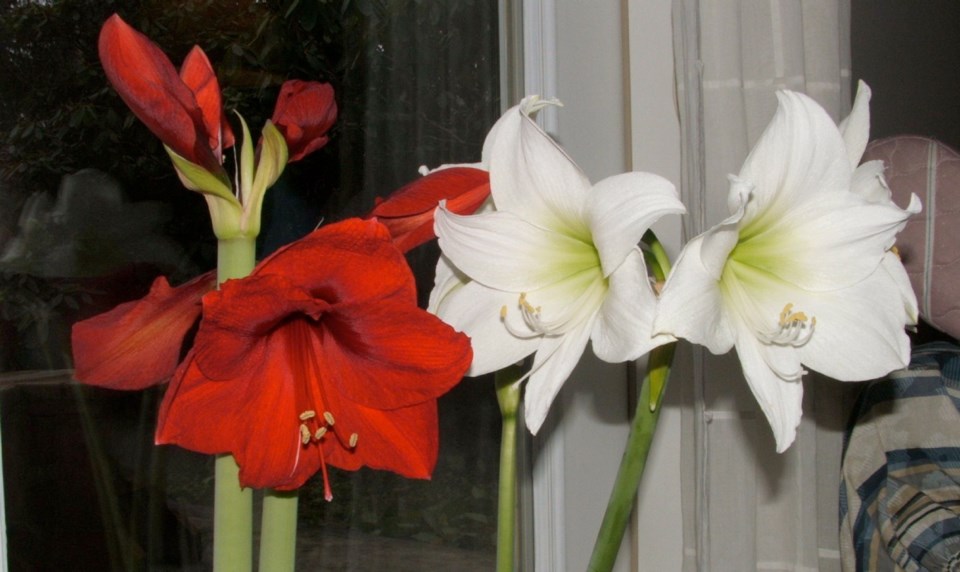Dear Helen: I keep coming across conflicting information on how to care for an amaryllis after it has finished flowering. I was thrilled with the flowers on a plant I was given, and would like to nurture the plant and rebuild the bulb enough to bloom again. — W.P.
I agree that it’s difficult to find total agreement on how to manage amaryllis bulbs. That’s because traditional methods have been challenged by ongoing research.
First, be aware that some amaryllis varieties are easier than others to carry over for re-bloom. In my experience, the older ones like Red Lion and Mont Blanc are among the easiest, but I’ve not grown all the many available varieties.
The path to bulb rebuilding begins as soon as a plant has finished flowering. Once that occurs, here are some steps to consider.
• Cut the flowers off to prevent the plant from expending energy in forming seeds.
• Though it may be temporarily unsightly, leave the flower stalk until it turns yellow. The green stem, along with the leaves, will work through photosynthesis to create bulb-rebuilding energy.
• Keep the plant growing as strongly as possible. Move it to the sunniest spot possible indoors, keep the soil well watered, and feed every two weeks with a house plant fertilizer mixed at half the label rates.
• In late spring or early summer, move the pot outdoors, making the move a gradual one into sun. Water regularly through the summer and fertilize monthly until late August.
• Well before frost in the fall, bring the plant back indoors to a sunny window, ideally in cool room temperatures.
• Amaryllis bulbs do not require a dormant period. They can be kept growing, and if the bulb has been well nourished it will bloom again. Or, you can choose to bring the pot in before frost and let the top growth dry off in a cool, dark, dry location. Remove leaves as they dry. Check the bulb occasionally and bring it back into active growth again with warmth, light and water after eight to 10 weeks of dormancy or when a flower bud begins nudging through the neck of the bulb.
• Repotting is necessary only every two or three years. It is best done after the bulb has completed a dormant period or, in the case of plants kept green, as new growth or a flower bud begin to emerge. In non-potting years, simply replace a top layer of planting mix with fresh.
Dear Helen: When I complained to a friend last summer about trying to control the chickweed in my vegetable plots, she told me it was a nutritious green vegetable and that I should cut and eat it. Is this true? — G.F.
Chickweed is loaded with vitamins and minerals including iron, calcium, magnesium, folic acid, vitamins C and A, and more. In moist, humus-rich soils the trailing plants produce succulent shoot tips that are mild and sweet. They can be added to salads, but I let the most robust and fleshy plants grow as a source of in-garden snacks.
GARDEN EVENTS
Lily meeting. The Victoria Lily Society will meet this evening at 7 in the Salvation Army Citadel, 4030 Douglas St. Colin Tamboline, society president, will present a talk on North American lilies and West Coast hybridizers.
Floral arts. The Mid Island Floral Art Club will meet on Thursday at 2 p.m. in St. Stephens Hall, 150 Village Way in Qualicum Beach. The afternoon’s theme: “Have a go at Vertical Line Design.”
Seedy in Port Alberni. The theme for Port Alberni’s Seedy Saturday, 10 a.m. to 2 p.m., is Grow Your Own. The event, at Char’s Landing, 4815 Argyle St., will feature a seed swap, vendors and workshops.
Gilkeson talks. Popular speaker and author Linda Gilkeson will be giving two talks on Saturday, March 23, at Kildara Farms, 11293 Chalet Rd. in North Saanich. From 11 a.m. to 1 p.m. Linda’s topic is Resilient Gardens in a Changing Climate. The afternoon talk from 2 to 4 is on Protecting and Attracting Beneficial Insects. Tickets at $18.50 for one talk or $30 for both are available at Russell Nursery, 1370 Wain Rd. in North Saanich, or online at russellnursery.com. For more information go to lindagilkeson.ca/calendar.html.
Volunteering at Government House. Anyone interested in joining the volunteer gardening crew at Government House is invited to an orientation meeting on Wednesday, March 20, at 10 a.m. in the McClure Room at Government House, 1401 Rockland Ave. in Victoria. Inquiries can be directed to newgardenvol@gmail.com.



